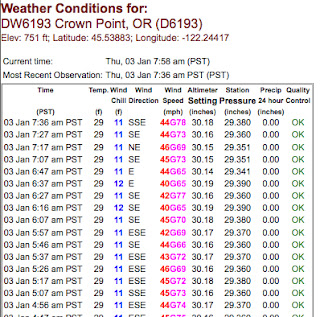 |
| Seattle Climatological Data |
 |
| Portland Airport |
 |
| Spokane Airport |
So we now at or close to the bottom for temperature, Thus, here in the Northwest our lowest temperatures are approximately two weeks after the winter solstice, (December 21) when the warming radiation from the sun is least and the days are shortest. Interestingly, in the summer there is a much longer lag between the maximum solar radiation on the summer solstice (June 21) and our warmest temperatures (early August). Clearly, solar radiation at the top of the atmosphere is not the only story for surface temperatures-weather systems and clouds play a role as well. For example, in summer we have lots of low clouds and onshore flow in June and early July that slows the warming.
Talking of climatological records, December broke one: Seattle had 27 days of measurable precipitation last month, an ALL TIME RECORD for December. The old record was 26 days.
There is now a large pressure difference across the Cascades, with high pressure entrenched over eastern Washington (see map) and an offshore trough approaching. The result has been very strong
winds in the Gorge, with some "favored" spots hitting 70-80 mph. One of the windiest places is the Vista House at Crown Point, where recent gusts have hit 78 mph, with sustained winds in the 40+ mph range (see graphic).
Finally, lets end with something we have not seen in while...a nice sunset shot. But this one had an added twist. Taken from my department, here was a low level contrail from a jet that left a shadow on a higher cloud deck....its above the third tower on the left side of the photo.






Cliff, this makes me wonder about the "seasons" and their starting dates. Shouldn't the "winter" period be halfway over this week if we're at it's coldest point? But we only just hit the start date of "winter" on Dec. 21st according to the calendar. If you could adjust the period dates for Winter, Spring, Summer, and Fall based on temps what would that look like? Summer start of July 5th? Fall starting later in Sept or early Oct? Winter starting in late November with heavy storms? Longer Spring period?
ReplyDeleteI really appreciate when you include discussion about Spokane weather. I don't know of anyone else who adds commentary on our weather over here. (Even if it is only passing in regard to western Washington)
ReplyDeleteThanks!
osucem, in many ways it makes more sense to divide the seasons based on the days halfway between equinox and solstice, which is roughly what the Chinese/East Asian scheme of things does. So the average hottest and coldest days would be in the middle of summer and winter, respectively.
ReplyDeleteThis is why "Chinese New Year" (a.k.a. Spring Festival in China--the start of spring), happens in the start of February or so, the middle of winter by western conventional calendars.
See here: http://en.wikipedia.org/wiki/Solar_terms
Looking at a graph of temperature and precipitation, I think an honest Seattle season calendar would inevitably prolong winter or spring! Or maybe shorten winter and prolong autumn and spring. It would definitely be lopsided!
I work primarily outdoors, so today's topic was of particular interest.
ReplyDeleteOn a side note, I saw several distinct areas of mammatus clouds over Everett at about 4pm today (they are so weird looking!); 3 hrs later there is sleet a little to the east.
Gladys
Doesn't the real date of a winter solstice depend on the latitude or is it strictly about the date of our orbital apogee?
ReplyDeleteAlex, I think the exact time of solstice varies locally, but only by a very small margin (it would be due to irregularities in the shape and orbit of Earth, etc). So it occurs on the same day regardless of latitude, which merely determines the degree of the sun's angle.
ReplyDelete